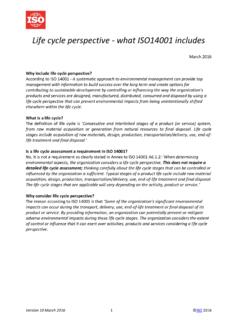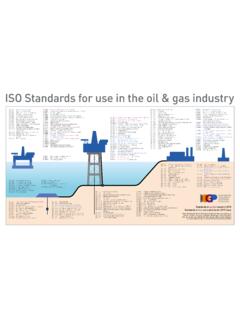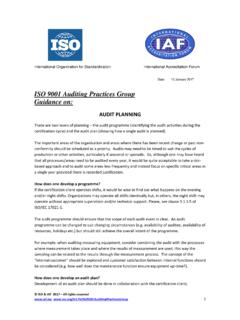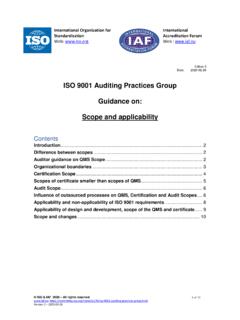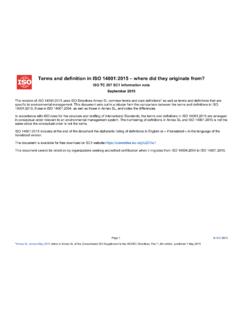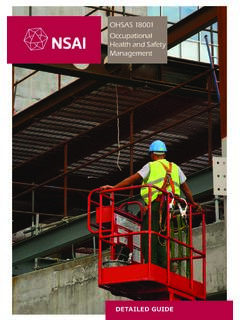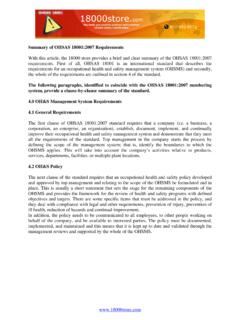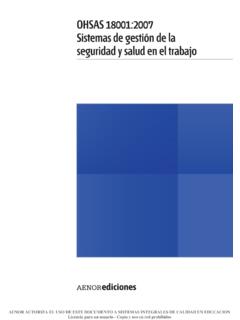Transcription of ISO 45001 - general questions
1 ISO 45001 - general questions ISO 45001 is good, but the enforcement is very important. So how is committee helping to enforce it? For most organizations the application of ISO 45001 , and the decision as to whether to seek certification, is a voluntary one, though in some specific situations the provisions of the standard may be included or referenced in legislation, or compliance with the standard may be a contractual requirement for the organization. It follows that enforcement often falls purely to the organization itself, or there may be a need to demonstrate conformance to a regulator, a certification body, or a client. ISO/TC 283 is therefore not directly involved in processes to enforce application of the standard, or processes to assess compliance. Our role is to help ensure that the requirements of the standard are clear and can be easily understood, and to provide guidance on their interpretation and application.
2 To do this we gather feedback from stakeholders, through national standards bodies and their mirror committees, and through public consultation. This includes providing answers to frequently asked questions via the committee website What if the top management of any organisation is not taking the lead in terms of giving the opportunity of communication between workers? Participation and consultation of workers is a requirement of ISO 45001 , therefore top management must ensure that this takes place and the related requirements on communication are also complied with, if they wish to claim compliance with ISO 45001 as a whole. How can an autocratic leadership style in an organization be overcome/handled while implementing the workers participation aspect of the standard? This has been a challenge in some of the ISO 45001 implementation projects as leadership commitment is key to realize full conformity to the standard requirements.
3 As noted in the question, leadership commitment is very important to ensuring success in managing OH&S risks and is a requirement in ISO 45001 . Workers responsible for OH&S management can help develop leadership support by demonstrating the benefits of improving OH&S performance to overall business objectives ( less sickness absence, less operational disruption due to accidents, less chance of litigation against the organization). If those responsible for OH&S ensure effective monitoring and evaluation of OH&S performance, it may be possible to demonstrate to leaders that workers' performance improves in those situations where workers are involved in making decisions and understand why rules or processes are in place. This can be done through limited interventions on specific issues. For example, team leaders could discuss with workers ideas of how to reduce the number of incidents relating to a particular hazard that affects them directly, getting agreement on the best way to manage that risk, then feeding back to leaders on the effectiveness of this approach when compared with a traditional approach of imposing controls without consultation.
4 Assessment of OH&S opportunities and other opportunities for the OH&S management system Shall be conducted the part of HIRA or can we do it separately? The identification, and assessment, of OH&S opportunities and other opportunities for the OH&S management system, can be carried out alongside, or separate from, the hazard and risk assessment (HIRA). Certainly, HIRA can be used to identify some opportunities, however additional assessment may be needed to ensure that opportunities are not missed if identification is too narrowly focussed via HIRA. When an organization implements ISO 45001 they should analyse the psychosocial risks, or only when implementing ISO 45003? ISO 45001 requires the organization to identify and assess all OH&S risks to workers, so this already includes psychosocial risks. ISO 45003 is being developed to provide additional guidance on this aspect, as it is one which many organizations have limited experience with, yet one which is becoming increasingly significant for many.
5 Is responsiveness and timeliness during emergencies and times of crisis sufficiently addressed? ISO 45001 contains a section specific to emergency preparedness and response. Although there is no specific mention of timeliness, the organization is required to test its plans periodically and to evaluate their effectiveness via these tests and any actual emergencies. Timeliness is clearly an important attribute when considering whether an emergency plan is effective, so it should always form part of such an evaluation. Can ISO 45001 be used to address and manage the human factors? Yes, human factors are among the factors affecting OH&S risks to workers. The organization should therefore consider human factors within the scope of its OH&S management system and use the ISO 45001 framework in addressing and managing the related risks.
6 Why does "worker participation" come together with "leadership" in the in the PDCA cycle? It is important to note that each requirement in ISO 45001 is independent and that the organization needs to comply with all requirements, regardless of the order in which they appear or how they are grouped together. There is no particular significance to the fact that these are grouped together within the document, other than because of the interaction between the two clauses: effectively meeting the requirements for leadership depends on meeting the requirements for worker participation and vice versa. Additionally, ISO 45001 uses the same clause structure as other management system standards such as ISO 9001 (Quality Management) and ISO 14001 (Environmental Management); putting the requirements for worker participation alongside those for leadership helps preserve that common structure, and is a useful reminder that together these elements are enablers of effective OH&S management.
7 Could you please explain more details about non-routine operation in order to address the risks and opportunities? Do we have to add the grading system for the risks and the opportunities that we have addressed? Please see the questions and answers on this topic on the TC 283 website - in the Frequently Asked questions section, in the area related to Clause 6 of the standard. Establishing (grading) the magnitude of risks, taking into account the controls in place, is key to establishing whether controls are sufficient or whether action is needed; this applies equally to routine and non-routine operations. In the case of non-routine activities, workers have to be trained in changes incorporated in the infrastructure, equipment, materials, physical conditions of the workplace and hazards arising from these changes.
8 If the situation persists for a longer period, should this non-routine activity be considered as having become routine activity? Yes, some non-routine can become routine activities over time. For example, some of the changes that organizations have introduced to address the Covid-19 pandemic may become permanent, and this should be reflected in training, process documentation, etc. It s important that when we adjust work and workplaces (in this case to reduce the risks of transmission of the virus) that we assess how changes affect the risks for regular (routine) activities, but also consider more occasional (non-routine) activities such as maintenance activities on equipment or buildings, and that we consider emergency arrangements such as evacuation to an assembly point. Can a company be certified as complying with the 45001 standard?
9 ISO 45001 can be used as the basis for a self-declaration of conformity by an organization, for a second party assessment of an organization by a client, or for external, independent third-party certification. Independent third-party certification of a management system is voluntary, in other words a choice on the part of the organization itself. That said, there are occasions where requirements for certification are applied in supply chains where a client organization requires its suppliers to be certified this is currently less common with ISO 45001 than, for example, with ISO 9001 (Quality Management). The credibility of any independent third-party certification, is influenced by the choice of certification body. National Accreditation Councils provide oversight of management system certification bodies ( certifiers or, in some countries registrars ), reviewing aspects of their work including competence and impartiality, but this accreditation is voluntary on the part of certifiers.
10 We would recommend organizations employ a certifier accredited for ISO 45001 . What is meant by a harassment from the point of view of 45001 ? By harassment ISO 45001 is referring to aggressive pressure, intimidation or bullying including behaviour that demeans, humiliates or embarrasses a person. Specific significant changes from ohsas 18001 please? Principal differences between the requirements of ISO 45001 and those of OSHAS 18001 are summarised in a PowerPoint presentation available on the ISO/TC 283 website ( ). These differences include: alignment to the structure and core requirements of other ISO management system standards ( ISO 9001); more emphasis on the context of the organization, leadership and worker participation and consultation.

